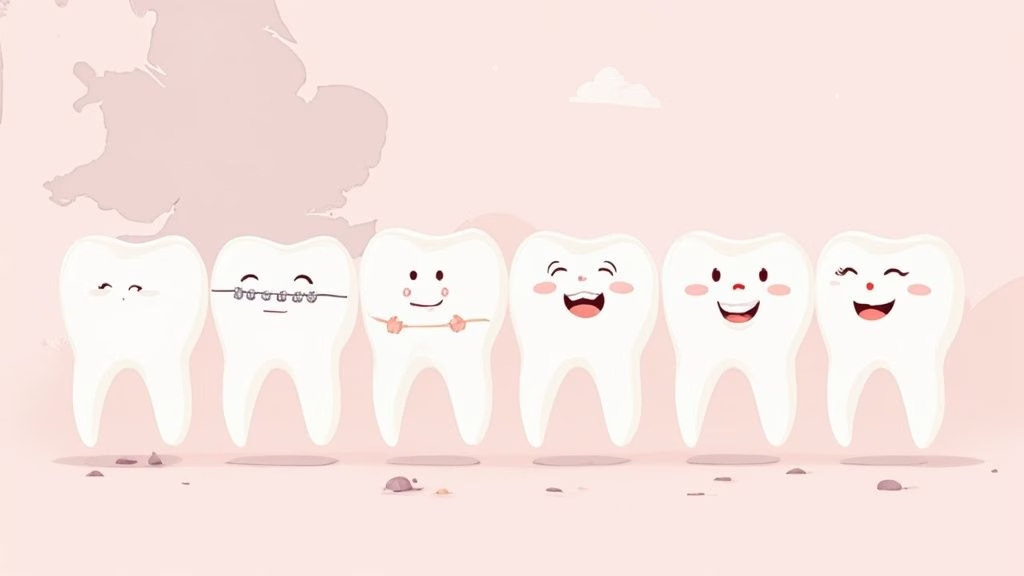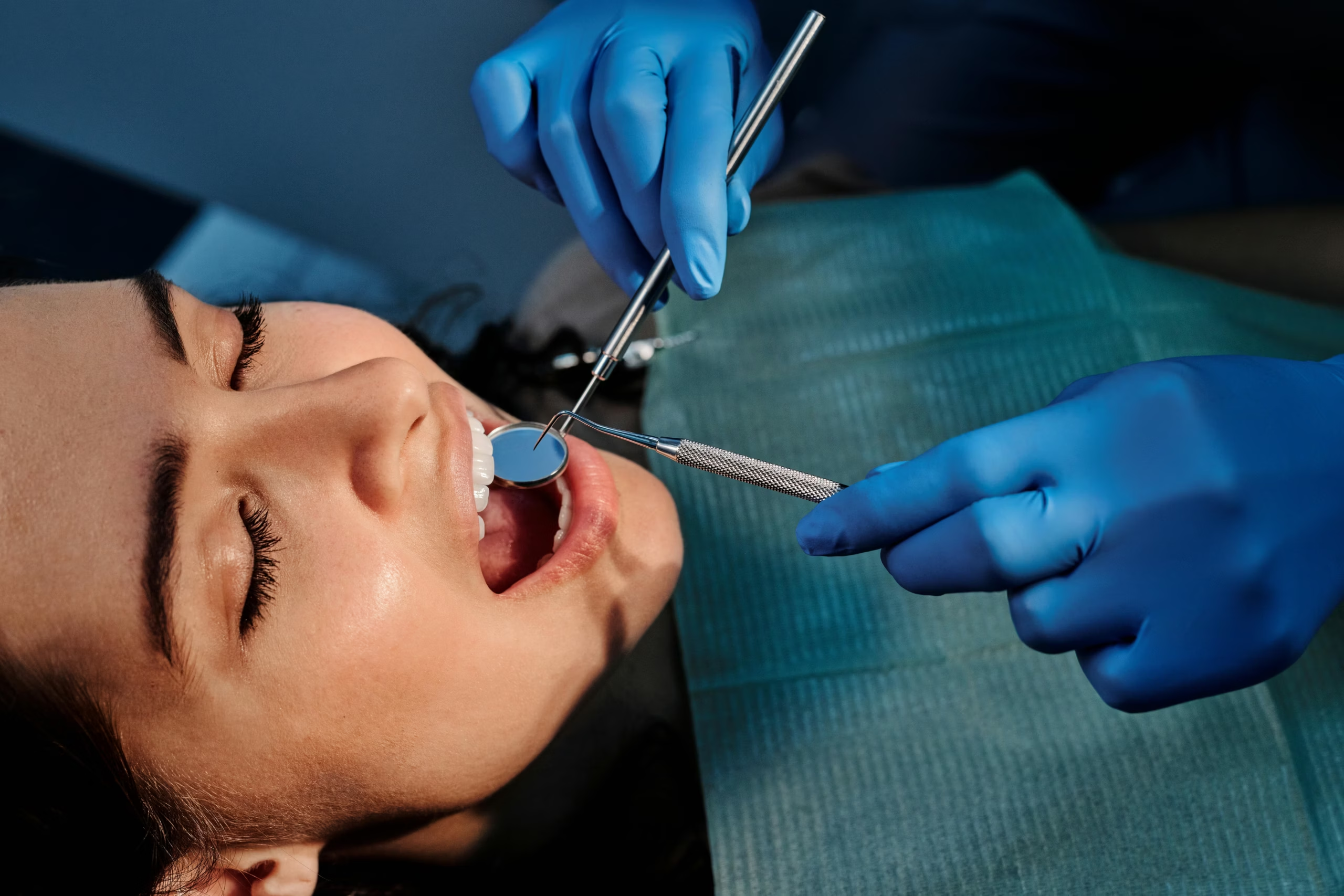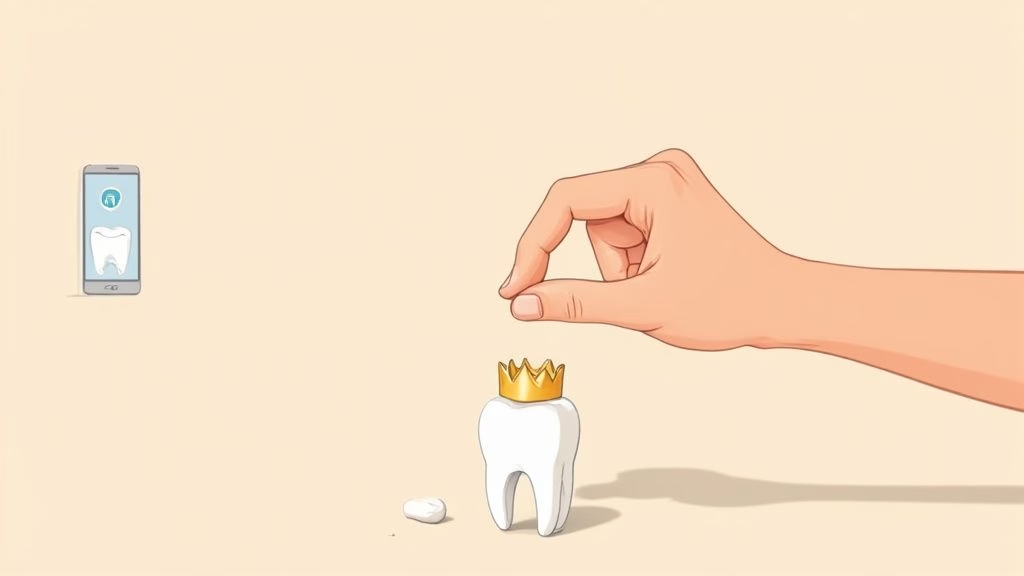How to Fix Underbite for a Straighter Smile
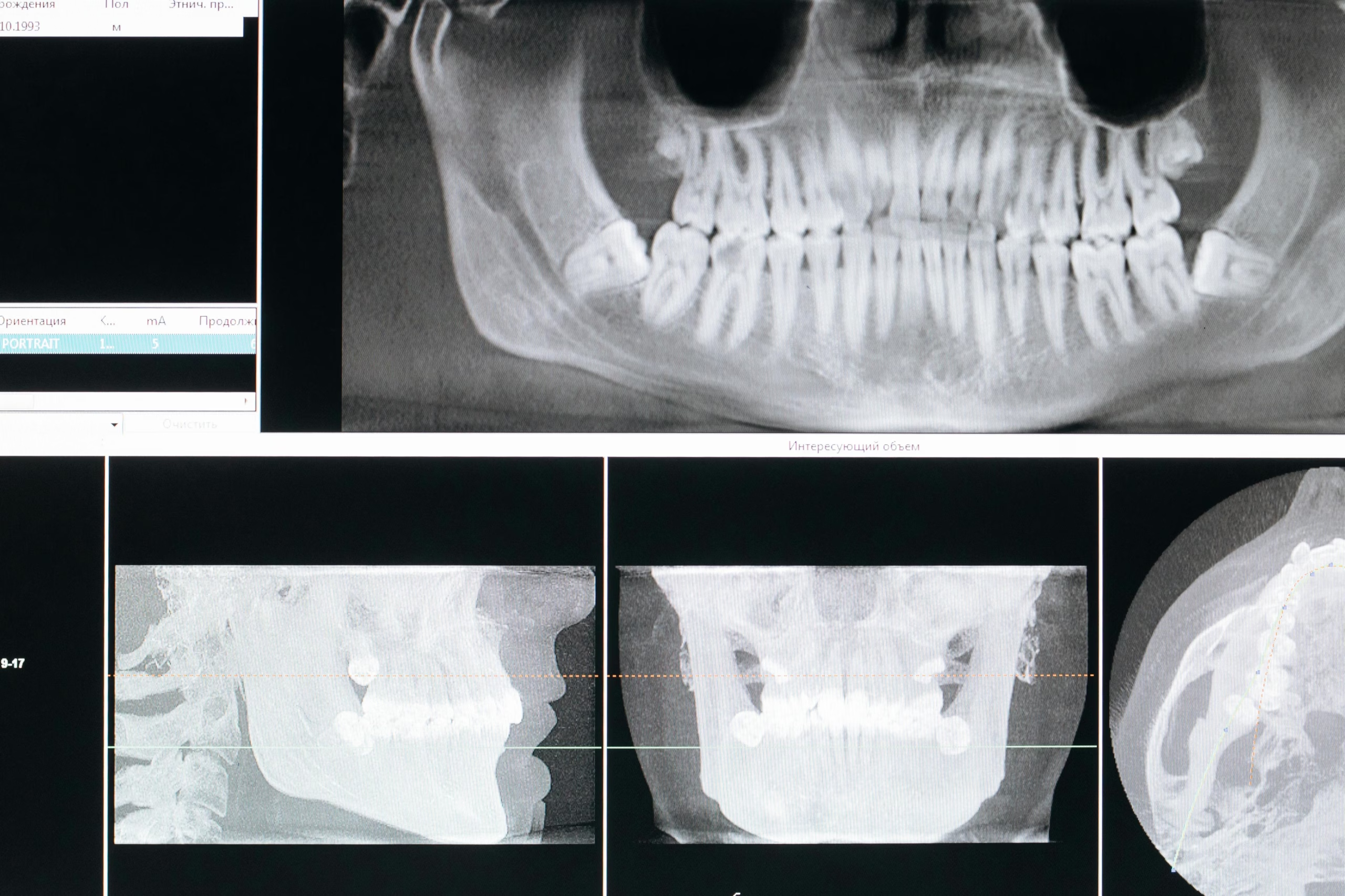
Correcting an underbite isn’t a one-size-fits-all process. The solution can range from straightforward treatments like clear aligners for minor issues, all the way to complex jaw surgery for more significant skeletal imbalances. Your age and the root cause of the misalignment are the biggest factors in deciding the best path forward, with the ultimate goal being to perfectly realign your teeth and jaw for a healthier, more comfortable bite.
What an Underbite Means for Your Smile and Health
Before we jump into the different ways to fix an underbite, it’s crucial to understand what it actually is and why it’s more than just a cosmetic quirk. An underbite is a specific type of misalignment where your lower teeth jut out and overlap your upper teeth when you close your mouth.
In clinical terms, we call this a Class III malocclusion. It’s often caused by the lower jaw growing too far forward, but it can also be a simple matter of tooth positioning.
The Root Causes of an Underbite
Getting to the “why” behind an underbite is the first step in creating an effective treatment plan. The causes usually fall into a few key categories, and it’s often a mix of factors.
- Genetics: This is far and away the most common reason. If your parents or other relatives have an underbite, your chances of having one are much higher. Jaw shape and size are heavily influenced by your genes.
- Childhood Habits: Certain habits during the early years can really affect how the jaw develops. Things like prolonged thumb-sucking, using a dummy for too long, or even tongue thrusting (where the tongue pushes against the front teeth when swallowing) can all guide the jaw into the wrong position.
- Injury: A serious injury to the face or jaw can cause it to heal improperly. This can result in a skeletal underbite that only becomes apparent later on.
While it might not seem like a big deal at first, leaving an underbite untreated can set off a chain reaction of problems that affect more than just your appearance.
To put it simply, understanding what causes an underbite helps us understand the problems it can create. Here’s a quick look at the connection.
Underbite Causes and Common Concerns at a Glance
| Primary Cause | Potential Impact |
|---|---|
| Genetics & Heredity | Inherited jaw structure can lead to chronic jaw pain (TMJ) and uneven tooth wear from birth. |
| Childhood Habits | Thumb-sucking or tongue thrusting can cause speech impediments like lisps. |
| Facial Injury | Trauma can alter jaw alignment, leading to significant difficulties with chewing and biting. |
This table shows that an underbite is rarely just a cosmetic issue; its roots are often linked to functional problems that affect daily life.
The Real-World Impact on Your Health
Living with an underbite often means facing daily challenges that most people never think about. This misalignment can interfere with the most basic functions of your mouth, leading to real discomfort and potential long-term health issues.
Many people with an underbite find they struggle with:
- Difficulty Chewing: An improper bite makes it tough to chew food properly, which can occasionally lead to digestive problems.
- Speech Impediments: The way your teeth and tongue align is vital for clear speech. An underbite can make it hard to form certain sounds, sometimes causing a lisp.
- Premature Tooth Wear: When teeth don’t line up correctly, they grind against each other in all the wrong places. This causes excessive wear on your enamel, making you more prone to chips, fractures, and decay.
- Jaw Pain and TMJ Disorder: The constant strain on your jaw joints from working overtime to compensate for the misalignment can lead to chronic pain, headaches, and clicking sounds. In many cases, it’s a direct contributor to temporomandibular joint (TMJ) disorder.
An underbite isn’t just about how your smile looks in photos. It’s a functional issue that impacts how you eat, speak, and feel every single day. Recognising this is the first step towards seeking a lasting solution.
In the UK, this isn’t a rare condition. Studies suggest that underbites affect roughly 5-10% of the population. With millions seeking dental care each year, orthodontic treatments for issues like underbites are a key part of our national oral health services. You can find more detailed information on dental statistics in England on the NHS website.
The good news is that modern dentistry has clear, effective ways to correct it. Smarter and more affordable options, like Toothfairy’s clear aligners, are making it easier than ever to fix mild to moderate underbites without the hassle of traditional braces. By understanding the signs and getting professional advice, you can find the right solution for you.
Exploring Your Non-Surgical Correction Options
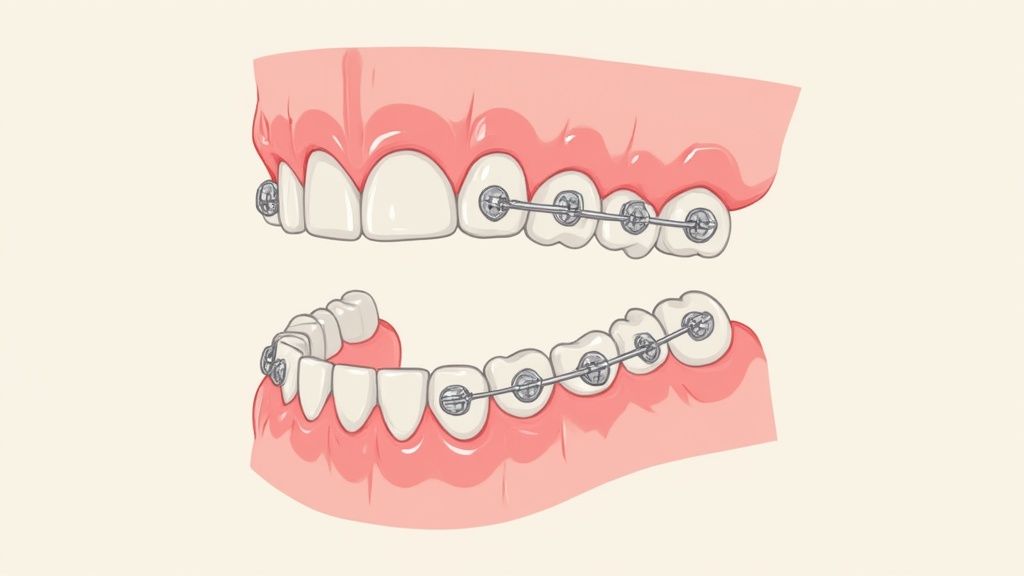
If the thought of surgery feels a bit much, take a breath. It’s often not the first or only port of call for fixing an underbite. For many people with mild to moderate cases, especially children and teenagers whose jaws are still growing, there’s a whole range of effective non-surgical treatments that can do the job.
These orthodontic solutions are all about applying gentle, consistent pressure over time. The goal is to gradually shift your teeth and, in some instances, guide the jaw’s position to create a healthier, more functional bite. Let’s walk through what these options look like in the real world.
The Time-Tested Method: Traditional Braces
For decades, traditional metal braces have been the workhorse for tackling complex orthodontic issues, underbites included. They use a system of brackets and wires to give an orthodontist precise, hands-on control over how each tooth moves.
This method is incredibly effective for both dental and mild skeletal underbites. For younger patients, we can even combine braces with other appliances to guide jaw growth, making some really significant corrections possible. While there’s no denying their power, they do come with the well-known downsides of being very noticeable and making a toothbrush and floss feel like a real chore.
The Modern Approach with Clear Aligners
Clear aligners have completely changed the game in recent years, becoming a hugely popular way to fix an underbite without the metal. They are custom-made, transparent trays that fit snugly over your teeth, applying targeted pressure to nudge them into place. Every one or two weeks, you pop in a new set, and each one brings you a step closer to your corrected smile.
What makes this option so appealing is how subtle and convenient it is. You can straighten your teeth without feeling self-conscious, which is a massive plus for adults and teens who aren’t keen on the look of traditional braces.
Clear aligners offer a powerful combination of clinical effectiveness and lifestyle convenience. They represent a smarter way to approach orthodontic treatment, empowering you to fix your underbite on your own terms, without putting your life on hold.
At Toothfairy, we’ve focused on making this technology more accessible and affordable than ever. We provide a fully remote, dentist-managed treatment plan that fits into your life, not the other way around. Instead of the frequent, time-consuming clinic visits that some aligner brands require, our process allows for professional monitoring from home, making it a much more practical choice for busy people.
Key Benefits of Choosing Clear Aligners
When you’re weighing up how to fix your underbite, the advantages of clear aligners are pretty compelling.
- Discreet Appearance: The transparent plastic makes them almost invisible. You can smile with confidence right through your treatment.
- Enhanced Comfort: Made from smooth, BPA-free plastic, aligners won’t irritate your cheeks and gums like metal brackets and wires often can.
- Improved Oral Hygiene: Because you take them out to clean your teeth, you can brush and floss normally. This massively reduces the risk of plaque build-up that can be a real headache with fixed braces.
- No Food Restrictions: Fancy a sticky toffee pudding or a crunchy apple? Just take your aligners out and enjoy. There’s no risk of damaging brackets or wires.
This blend of features is precisely why so many people looking to correct a mild or moderate underbite are choosing clear aligners.
Specialised Appliances for Early Intervention
When we spot an underbite developing in a child, getting in early can make a world of difference and often helps them avoid more invasive treatments down the line. An orthodontist might recommend a specific appliance designed to influence jaw growth.
Upper Jaw Expander (Palatal Expander)
This clever device is fitted to the roof of the mouth and works by gradually widening the upper jaw. By putting gentle pressure on the upper molars, it encourages the bone to grow, creating the space needed for teeth to align properly. It’s especially effective when an underbite is caused by a narrow upper jaw.
Reverse-Pull Headgear
Also known as a facemask, this appliance is used to encourage the upper jaw to grow forward and catch up with the lower jaw. It typically involves a frame resting on the forehead and chin, with elastic bands that attach to braces on the upper teeth. The headgear applies a gentle forward pull, stimulating the maxilla’s forward growth.
These appliances work best in children before their main growth spurt, while their jaws are still pliable. By tackling the skeletal imbalance early on, we can create a stable foundation for a healthy bite, often simplifying—or even eliminating—the need for more orthodontic work later.
When Jaw Surgery Is the Right Choice for an Underbite
While braces and aligners work wonders for many, some underbites are rooted deeper—in the structure of the jawbones themselves. When we’re talking about a significant skeletal underbite, where the jaw misalignment is pronounced, orthognathic surgery often becomes the most effective, life-changing solution.
The thought of surgery can be daunting, I get it. But this is a well-established procedure that delivers results far beyond what orthodontics can achieve alone. Think of it as a close partnership between an oral and maxillofacial surgeon and your orthodontist, working together to bring your bite, jaw, and facial profile into perfect harmony.
Identifying the Ideal Candidate for Surgery
Opting for jaw surgery isn’t a quick decision; it’s a meticulous process that begins with a comprehensive evaluation. Generally, orthognathic surgery is recommended once the jaw has finished growing, which is why it’s almost always performed on adults.
So, who is a strong candidate? You might be if you’re dealing with:
- Significant skeletal discrepancies: This is when the size or position of your upper and lower jaws are mismatched to a point where simply moving the teeth isn’t enough.
- Severe functional problems: If your underbite makes it genuinely difficult to chew, speak clearly, or even breathe properly (including issues like sleep apnoea), surgery can offer profound relief.
- Chronic jaw pain (TMJ): For some, the constant strain from a severe underbite leads to a persistent TMJ disorder. Surgically realigning the jaw is often the only way to fix the root cause of the pain.
- Noticeable facial asymmetry: A significant underbite can really affect your facial appearance. Surgery can restore a natural balance and symmetry to your features.
For those considering this path, it’s really helpful to get a broader understanding reconstructive surgery and its goals. It puts into context how the procedure works to correct structural issues rather than just cosmetic ones.
The Surgical Journey Demystified
The road to a corrected bite through surgery is a multi-stage process, typically spanning 18 to 24 months. It’s carefully structured to ensure your teeth are in the perfect position to meet correctly once your jaw alignment is fixed.
Jaw surgery is so much more than a cosmetic fix; it’s a functional restoration. The goal is to create a healthy, stable foundation for your bite that will support your overall oral health for a lifetime.
The entire process is planned with incredible detail and follows a clear timeline with distinct phases, each one playing a vital role in the final success.
Pre-Surgical Orthodontics
The journey almost always starts with orthodontics. It might seem backwards to have braces before the main event, but this step is absolutely crucial. The orthodontist’s job here is to straighten the teeth on each jaw independently. This way, they will slot together perfectly after the surgeon repositions the jawbones.
This phase can last from 12 to 18 months, and during this time, your bite might actually feel like it’s getting worse. Don’t panic! This is a completely normal and expected part of the process. Your teeth are being moved into their ideal positions in preparation for the surgery.
The Surgical Procedure
Orthognathic surgery is performed by a specialist surgeon in a hospital, and you’ll be under general anaesthesia. The surgeon makes precise cuts to the jawbone—sometimes the upper jaw, sometimes the lower, sometimes both—moves it into the correct alignment, and then secures it with tiny plates and screws.
The best part? It’s all done from inside your mouth, which means no visible facial scars. It’s an incredibly precise operation designed to create a result that is both functional and aesthetically balanced.
Post-Surgical Recovery and Finishing Touches
After the operation, you’ll move into the recovery phase. Expect some swelling and a temporary diet of liquids and soft foods while your jaw heals. Once you’re feeling up to it, the final phase of your orthodontic treatment begins.
This last stage is all about the fine-tuning. Your orthodontist will make small adjustments to ensure every single tooth meets its partner perfectly. This phase is usually much shorter, often lasting around six months. This is also where modern solutions like Toothfairy’s clear aligners can be a great option, offering a more discreet and comfortable way to complete your post-surgical orthodontic work. It’s a smart way to manage this final stage, blending clinical precision with the convenience of remote check-ins.
Fortunately, for many people in the UK, cost isn’t the barrier it might seem. For children under 18, underbite correction surgery and the related orthodontics are provided free on the NHS. For adults where the surgery is deemed medically necessary, a single fixed treatment charge covers the entire process, including the braces before and after.
Comparing Your Underbite Treatment Options
Deciding on the best way to fix your underbite can feel overwhelming. With several effective paths available, the right choice really comes down to your unique situation—how severe your underbite is, your age, your lifestyle, and of course, your budget.
To make things a bit clearer, let’s put the main treatment options side-by-side.
Understanding the success rates of different approaches gives you some valuable context. This infographic breaks down the typical outcomes you can expect from the most common underbite correction methods.
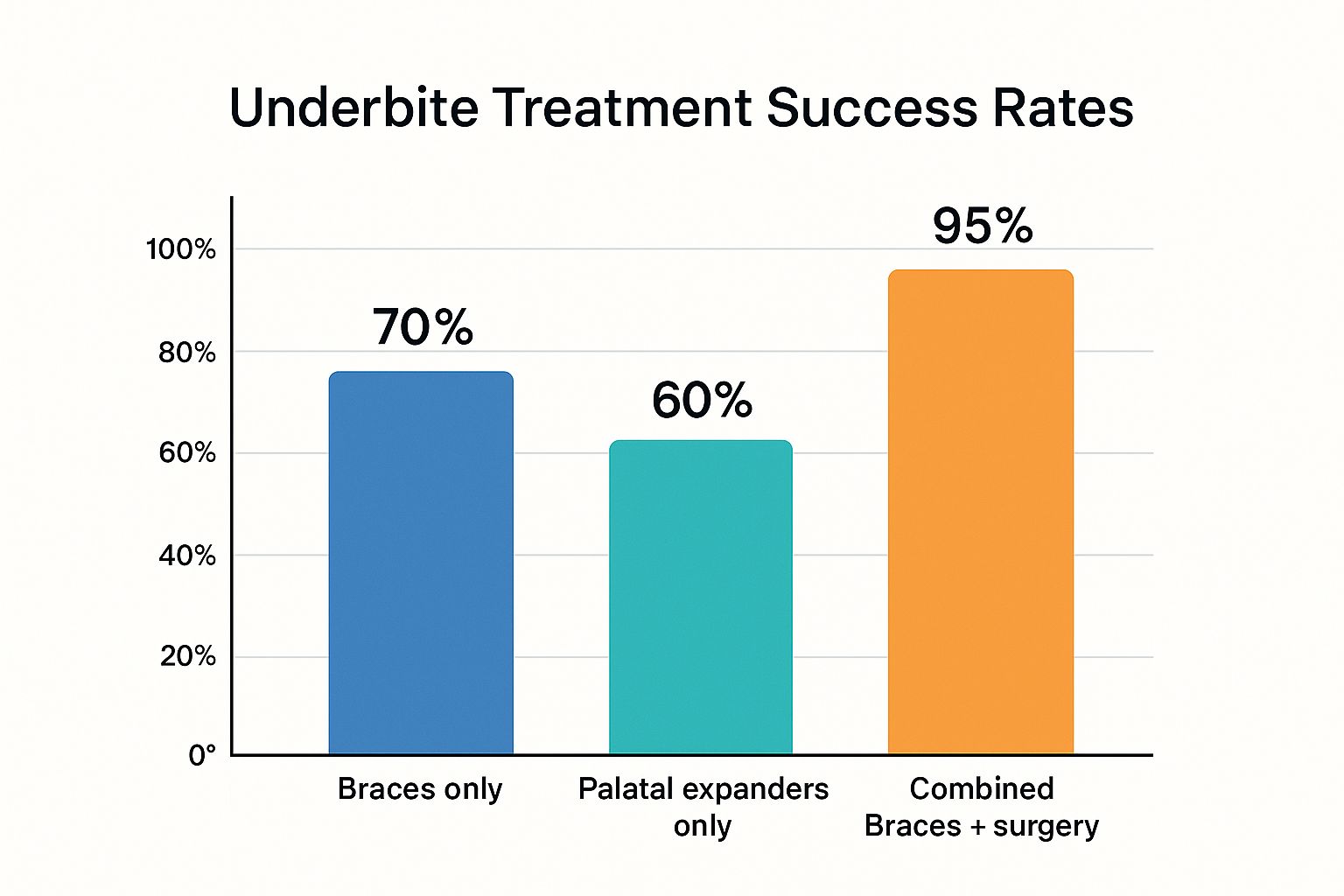
As you can see, combining orthodontics with surgery offers the highest success rate for more severe skeletal issues. However, non-surgical methods like braces and aligners are still incredibly effective for the right candidates. It really underscores how vital it is to match the treatment to the individual.
Key Factors in Your Decision
When you’re weighing up the pros and cons, think about what matters most to you. Is a discreet look your top priority? Is cost a major factor? How much time can you realistically commit to appointments? Answering these questions will help point you towards the best fit.
A direct comparison is often the easiest way to organise your thoughts and see the distinct advantages of each method. Let’s break it down.
Comparing Your Underbite Correction Methods
Choosing the right underbite treatment is a big decision. This table offers a direct comparison of the most common methods to help you see which one best aligns with your needs, budget, and lifestyle.
| Treatment Method | Best For | Average Cost | Visibility | Toothfairy Advantage |
|---|---|---|---|---|
| Traditional Braces | Moderate to severe dental and mild skeletal underbites in children and adults. | £2,500 – £5,000 | Highly visible metal brackets and wires. | N/A – Traditional method. |
| Jaw Surgery | Severe skeletal underbites in adults where the jaw has stopped growing. | £10,000+ (often covered by NHS if medically necessary) | Surgery is internal, but post-op swelling is expected. | Can provide post-surgical aligners for a more discreet finishing phase. |
| Specific Aligner Brands | Mild to moderate dental underbites, primarily for adults and teens. | £3,500 – £6,000 | Almost invisible, but may require noticeable attachments on teeth. | Can be more expensive and often require frequent in-person clinic visits. |
| Toothfairy Aligners | Mild to moderate dental underbites in adults and teens seeking convenience. | More affordable than other brands, with flexible payment plans. | The most discreet option, with no metal and minimal attachments. | Affordable, convenient, and dentist-managed from home, saving you time and money. |
Ultimately, this comparison shows there’s no single “best” option—only the best option for you. While surgery is the definitive solution for major skeletal problems, for many people with mild to moderate underbites, the real choice boils down to different types of orthodontics.
Lifestyle and Personal Preferences
Your day-to-day life plays a huge part in this decision. If you’re a professional who spends a lot of time in meetings, you might prioritise a discreet treatment, making clear aligners a much better choice than traditional metal braces.
On the other hand, if you have a hectic schedule, the remote monitoring offered by services like Toothfairy can be a game-changer. It completely cuts out the need for constant trips to a clinic, which is a massive plus for busy people.
Choosing how to fix your underbite is a personal journey. The best treatment is one that not only corrects your alignment effectively but also fits seamlessly into your life, making the entire process feel manageable and positive.
For anyone with a mild to moderate underbite, clear aligners are a powerful, modern solution. They deliver excellent results without the aesthetic and practical headaches of fixed braces. Toothfairy takes this a step further by making the process smarter and more affordable, putting professional, dentist-led care directly into your hands, right from your own home.
The final, crucial step is having a confident and informed chat with a dental professional. They can help you confirm the ideal path forward for your smile.
Keeping Your New Smile in Place After Treatment
You’ve done it. After all the appointments and adjustments, you finally have the smile you’ve worked so hard for. It’s a huge achievement, but the journey isn’t quite over. Now, it’s all about maintenance—protecting your investment and making sure those fantastic results last a lifetime.
Think about it: after months or even years of treatment, your teeth and jaw need time to properly settle into their new positions. The ligaments and bone that hold everything in place have a sort of ‘memory’ and a natural tendency to shift back to where they were. This is why what you do after the braces come off or the surgery is done is so critical for long-term success.
Your Retainer: The Non-Negotiable Guardian of Your Smile
Consider your retainer the insurance policy for your new smile. Without it, you run a very real risk of orthodontic relapse, where your teeth slowly start to drift back towards their old, crooked positions. The single most effective way to stop this from happening is to wear your retainer exactly as your orthodontist tells you to.
At first, you’ll probably be wearing it full-time, only taking it out to eat, drink, or brush your teeth. As your jaw and teeth stabilise, your orthodontist will likely give you the green light to switch to wearing it only at night.
Your orthodontic treatment got your teeth to the finish line, but your retainer is what keeps them there. Consistent use is what turns a temporary fix into a permanent, confident smile.
Keeping your retainer in good shape is simple, but it’s essential for it to do its job properly. Here are a few tips I always give my patients:
- Clean it every day. A soft-bristled toothbrush and a non-abrasive cleaner are all you need to gently brush away any plaque or bacteria.
- Store it safely. When it’s not in your mouth, your retainer should be in its case. This simple habit prevents it from getting lost, stepped on, or even accidentally chucked in the bin.
- Keep it away from heat. High temperatures can warp the plastic, ruining the fit. Never leave it in a hot car or try to clean it with boiling water.
Modern services like Toothfairy have made this final stage much easier, offering convenient and affordable retainer options. This ensures you have what you need to protect your smile without it costing a fortune.
Enjoying the Life-Changing Benefits
Beyond the practical side of maintenance, take a moment to appreciate the incredible outcomes of your journey. Correcting an underbite does so much more than just straighten your teeth—it can genuinely improve your quality of life.
Many people tell me about the huge boost in their self-confidence. Feeling proud of your smile can change how you carry yourself, whether that’s speaking up in a meeting or just smiling for a photo without thinking twice. On a functional level, you’ll likely find chewing is easier, your speech is clearer, and any jaw pain you had has eased off.
Of course, maintaining good oral health is central to keeping these results. The UK’s 2021 Adult Oral Health Survey pointed out that dental problems often increase with age and are linked to socio-economic factors, with 16% of adults reporting loose teeth. Tackling issues like an underbite early on is strongly linked to better long-term oral health, which just goes to show how important ongoing dental care is. You can read more about these UK oral health findings on the government’s website.
Regular dental check-ups and a solid hygiene routine are your best defence. The good news? With your beautifully aligned smile, looking after your teeth is now simpler and more rewarding than ever.
Common Questions About Fixing an Underbite
Deciding on the best way to correct an underbite naturally brings up a lot of questions. From how long it will all take to whether it’s going to hurt, getting clear, straightforward answers is key to feeling confident about the journey ahead. Let’s walk through some of the most frequent queries we hear from patients.
Can an Underbite Be Fixed Without Surgery?
For many people, the answer is a resounding yes. If you’re dealing with a mild to moderate dental underbite (where the issue is mainly about tooth position), non-surgical treatments are often incredibly effective.
Orthodontics is the go-to solution here. Modern clear aligners, like those we design at Toothfairy, and traditional braces both work by applying steady, gentle forces to guide teeth into their correct alignment. These methods are perfect when the problem is with the teeth, not the jawbone itself. Surgery is usually only brought into the conversation for more severe skeletal underbites, where the jaw’s position needs to be physically changed.
How Long Does Treatment Usually Take?
The timeline for correcting an underbite can vary quite a bit, depending on the severity of your case and the treatment you choose. It’s definitely a marathon, not a sprint, but the payoff is a lifetime of better health and confidence.
- Clear Aligners: For less complex cases, aligner treatment with Toothfairy can often achieve fantastic results in 6 to 18 months. This makes it a popular and faster choice for many adults.
- Traditional Braces: A full course of treatment with fixed braces might take anywhere from 18 months to 3 years, especially if the bite is particularly tricky.
- Jaw Surgery: When surgery is needed, the entire process—including the essential orthodontic work before and after the operation—typically takes about 18 to 24 months from start to finish.
Your dentist or orthodontist will give you a much more precise, personalised timeline once they’ve completed a full assessment.
Will Underbite Correction Be Painful?
It’s completely normal to expect some discomfort, particularly right after you start treatment or following an adjustment. But “pain” is probably too strong a word. Most people describe it as a dull ache or a feeling of pressure as their teeth and jaw adapt to the new forces.
Think of it as a sign that everything is working as it should! With clear aligners, you might feel this tenderness for a day or two after switching to a new tray, but it usually fades quickly. Simple over-the-counter pain relief is more than enough to manage it.
One of the biggest myths about orthodontics is that it’s a constantly painful experience. The reality is that it’s a series of small, manageable adjustments. That temporary discomfort is a small trade-off for the huge long-term benefits to your smile and function.
What Happens If I Don’t Fix My Underbite?
Leaving an underbite unaddressed can open the door to a host of other health problems down the line. While a very minor misalignment might never cause any trouble, moderate to severe underbites often lead to a domino effect of complications.
If left untreated, you could face:
- Chronic jaw pain and a higher risk of developing a TMJ (temporomandibular joint) disorder.
- Uneven and premature wear on your tooth enamel, leading to chips, fractures, and cavities.
- Trouble with chewing and biting food properly, which can sometimes impact digestion.
- Speech difficulties, like a lisp, which can understandably affect your confidence.
Tackling an underbite is a genuine investment in your long-term health. For more great insights into dental health and patient care, you can explore the Advanced Dentistry blog. Addressing the issue sooner rather than later can help you avoid more complex and expensive treatments in the future.
Ready to take the next step towards a healthier, more confident smile? At Toothfairy, we make fixing your underbite simple, affordable, and convenient with our dentist-managed clear aligners. We’re a smarter way to handle everything from teeth straightening to dental emergencies and cosmetic work. Find out if you’re a candidate today and start your journey from the comfort of your home. Learn more and get started with Toothfairy.
Last updated on October 13, 2025

Toothfairy Care Team
Toothfairy, is the world's smartest dental app, that connects patients to a dentist for a range of issues, from emergencies, cosmetics, prescriptions to virtual exams.
Toothfairy Care Team
Toothfairy, is the world's smartest dental app, that connects patients to a dentist for a range of issues, from emergencies, cosmetics, prescriptions to virtual exams.

